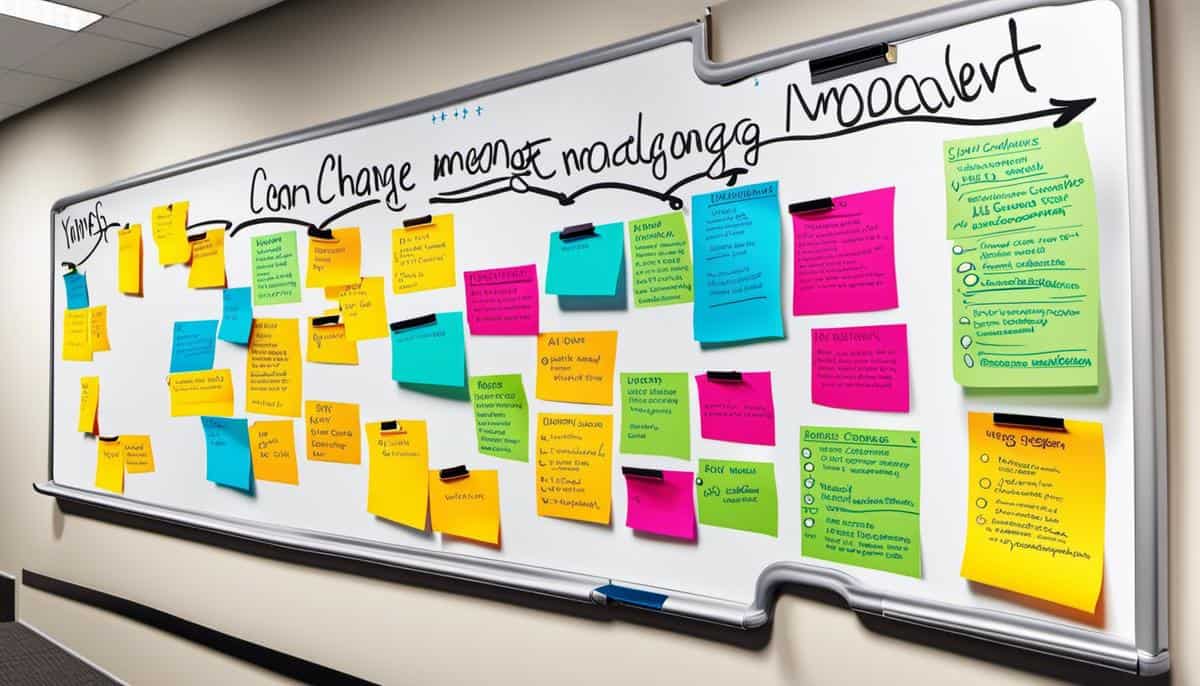In the dynamic world of business, fluidity and adaptability have become prerequisites for organizational success.
Central to this notion are the concepts of project management and change management, which often serve as the backbone of strategic operations within successful industries. Managing projects entails the concrete execution of outlined plans, skillful resource management, and the achievement of preset objectives.
On the other hand, managing change is about navigating the fluctuating tides of the market, technology, and organization itself, ensuring smooth transitions and adept manoeuvring through unfamiliar landscapes.
Let’s ventures into the depths of both these critical areas, seeking to provide a comprehensive understanding of their functionalities, significant players, methodologies, and life cycles.
Understanding Project Management
Understanding Project Management: An Overview
Project management is a methodical approach to planning and guiding project processes from inception to completion. It involves organizing and managing resources in such a way that these resources deliver all the work required to complete a project within the specified scope, time, and cost constraints. The process of project management generally involves identifying requirements, establishing clear and achievable objectives, balancing the competing demands from different stakeholders and ensuring that a commonality of purpose is achieved.
The Importance of Project Management
The very essence of project management lies in the effective and efficient guiding of all aspects of project processes, from initiating to planning, executing, monitoring, controlling, and closing. Project management is crucial in avoiding pitfalls and budget overflows, and in ensuring that the entire team understands objectives and stays on schedule. A well-executed project management strategy can make the difference between projects that meet their goals and those that don’t.
Project Management in Various Industries
In industries such as IT, construction, healthcare, and manufacturing, project management is a critical ingredient for success. However, because every industry has its unique set of business requirements, objectives, and functions, project management strategies often differ from one sector to another. Nevertheless, the fundamental objective remains the same – to ensure the efficient execution of projects.
Project Management Methodologies
There are numerous project management methodologies adopted by organizations for the effective execution of projects. Some of the popular methodologies include Waterfall, Agile, Scrum, Lean, and Kanban. Each methodology has its unique process and advantages, and they are chosen based on the needs of the project or the organization. For instance, the Waterfall model is a sequential design process, while Agile is an iterative approach to project management, often used in software development.
Project Management Tools and Techniques
Project management tools and techniques are integral for successful project management. They assist project managers and teams to manage projects effectively and efficiently. These tools can range from software applications like Microsoft Project, Basecamp, or Trello, to the use of Gantt charts for planning and scheduling, risk management tools for identifying and mitigating risks, or communication tools for effective team collaboration.
Change Management in Relation to Project Management
Change management is a planned approach to managing the transition or transformation of an organization’s goals, processes, or technologies.
It is closely related to project management, especially on projects that introduce significant change to an organization.
Effective change management in project management ensures that any changes in a project scope, schedule, or resources are precisely managed and flawlessly implemented, reducing resistance, increasing engagement, driving operational efficiency, and supporting business transformations.
Change and project management go hand in hand – you can’t successfully deliver a project that implements change without considering how this change will be managed and received.
Understanding the Symbiosis of Project and Change Management
Both project management and change management are interconnected disciplines that contribute significantly to the success of an enterprise.
The former is centered around the strategies, decisions, and actions involved in delivering a project successfully, whereas the latter is concerned with making sure that a project’s outcomes are acknowledged, assimilated, and used effectively by a particular organization.
In combination, they facilitate a comprehensive model that ensures projects are executed as planned – in terms of time and expenditure, and also enables workforce to respond constructively to changes, thereby maintaining continuous operational success across the entire organization.

Project Management Life Cycle
Dive into the Lifecycle of Project Management: A Stage-by-Stage Perspective
The lifecycle of project management is an inclusive process that spans different phases – from commencement to termination, devised with an agenda to effectively steer a project towards successful completion.
Initiation Stage
The initial stage of any project management cycle is initiation. The primary objective of this stage is to define the project scope, establish its objectives, and understand its potential value or return on investment. This stage generally involves risk identification, project feasibility studies, and stakeholder identification. Furthermore, it also entails establishing a project charter, a document that officializes the project, outlines its purpose and objectives, and empowers the project manager with the authority to utilize organizational resources to drive the project.
Planning Stage
The second stage in the project management life cycle is planning. This stage involves setting out a detailed project roadmap to achieve the set objectives. Key activities include developing a detailed project plan, project schedule, budget allocation, and communication plans. It also involves setting out quality measures, procurement planning, and risk mitigation strategies. The culmination of this stage is a consistent and coherent document – the Project Management Plan (PMP) – that drives the subsequent stages.
Execution Stage
The execution stage is where the defined project plan is actioned. The project manager’s role involves directing the team to meet project milestones and manage stakeholders’ expectations. Daily management tasks, team leadership, stakeholder communication, resource management, and quality control monitoring are typically performed during this stage. Adjustments to the initial plans are made based on changes in project requirements, resource availability, or other unforeseen circumstances.
Monitoring and Control Stage
The monitoring and control stage often overlaps with the execution stage. The purpose at this stage is to ensure the project is kept on track by constantly reviewing the project’s progress against its planned objectives. Key activities include tracking the project performance, monitoring risk, and quality control. Any deviations are immediately addressed, and corrective measures are applied.
Closing Stage
The closing stage of the project is just as important as its kick-off. Upon project completion, the project manager helps facilitate a project review to introspect what went well and what didn’t. The focus is on documenting lessons learned, conducting project audits, releasing project resources, and formalizing project closure. This stage provides valuable insights and best practices for future projects.
A harmonious combination of project management life cycle and change management is vital for an organization’s strategic evolution. This overlap supports businesses in maintaining their strategic direction while seamlessly adapting to changes. By having a systematic approach to plan, monitor, execute, and close changes, organizations can proactively mitigate resistance and bridge the gap between the old and new phases. This synergistic approach is instrumental in fostering a successful adoption of changes.

Photo by mariannebos on Unsplash
Diving into Change Management
An In-depth Look at Change Management
Change management involves a strategic, systematic methodology employed by businesses to smoothly handle alterations and adaptations within their structures. It’s a comprehensive approach that merges various processes, tools, and techniques to manage the human aspect of organizational changes, thereby successfully accomplishing the desired business results. Changes may vary widely, they can be strategic shifts, technological upgrades, structural modifications, or even adjustments in the mindsets and behaviors of the staff members.
The primary goal of change management is to ensure that organizational modifications are carefully implemented and that benefits are sustained in the long term. This approach greatly reduces risk associated with change by providing a well-structured support system for personnel during the transition period.
Change Management and Uncertainties
In an unpredictable business environment, adaptability and agility are paramount for an organization’s survival. Change management helps tackle uncertainties by planning, tracking, and managing the change process efficiently. It identifies potential risks and barriers, creating sustainable solutions, thus reducing the ambiguity during the transitions.
Change management takes a proactive approach, anticipating uncertainties and making strategy alterations accordingly instead of being reactively managed by circumstances. By implementing clear communication strategies, providing resources, and training, it enables individuals and teams to handle the shift smoothly, maximizing the overall business productivity while minimizing staff resistance or confusion.
Change Management in Project Management
Change management is a vital aspect of project management that works hand-in-hand to ensure the project’s success. Project management focuses on the project’s tasks and activities, while change management concentrates on the human aspects and the impact on stakeholders.
Projects often bring about change, and without a well-established change management process, projects can struggle to achieve their objectives. The project manager’s role includes creating a change management plan detailing how changes will be addressed and managed throughout the project. It ensures that changes are implemented systematically without negatively impacting the timeline or budget of the project.
Why is Change Management So Crucial?
Change management is pivotal in today’s dynamic business environment where every organization continuously evolves, making change an inevitable process. It effectively mitigates employee resistance, lowers the probability of reverting to outdated practices, and bolsters the likelihood of a project’s successful outcome.
By stratifying attention on the human aspects of change, change management equips and support individuals to successfully adopt changes. It ensures that stakeholders fully comprehend the advantages of the change, the reasons behind it, and aids them in adjusting more efficiently and positively.
In essence, strong change management practices serve as a fulcrum, maintaining a balance between essential operational requirements and the need for innovation and embracing new methodologies. With a deep understanding of its principles, every member of the organization can contribute to more seamless transitions, ensuring consistent achievement of goals while reducing the potential negative impacts of changes.

Change Management Models & Strategies
Decoding Change Management Models and Strategies
Change management encompasses the methods employed by businesses to guide individuals, teams, and the entire organization from a present state towards a targeted future state. Widely recognized for playing a key role in project management, it incorporates strategic planning, deployment, and communication to reliably fulfill business objectives. Prominent change management models and strategies that have shown high impact include the Lewin Change Management Model, the ADKAR Model, and Kotter’s 8-Step Process.
Change Management Model: The Lewin Model
Developed by psychologist Kurt Lewin, the Lewin Change Management Model proposes three main stages: unfreezing, changing, and refreezing. ‘Unfreezing’ involves preparing the organization for change, often by creating dissatisfaction with the current state. ‘Changing’ is the process of implementing a new strategy, guided by new information and attitudes. ‘Refreezing’ is where the new changes are consolidated and embedded into the organization’s culture. This model is popular due to its simplicity and applicability to various business scenarios.
Change Management Model: The ADKAR Model
The ADKAR Model, developed by Prosci, is an acronym that stands for Awareness, Desire, Knowledge, Ability, and Reinforcement. Five linear steps maximize business results and drive change effectively. ‘Awareness’ involves understanding the need for change. ‘Desire’ is creating a willingness and engagement for change among the workforce. ‘Knowledge’ includes training and education about the change. ‘Ability’ refers to turning knowledge into action. Finally, ‘Reinforcement’ ensures the changes stick by rewarding success and analyzing performance gaps.
Change Management Model: Kotter’s 8-Step Process
Developed by Harvard Business School professor John Kotter, the 8-Step Process advocates the understanding of change as a multi-stage process. The steps are: creating a sense of urgency, forming a powerful coalition, creating a vision for change, communicating the vision, removing obstacles, creating short-term wins, building on the change, and anchoring the changes in corporate culture. The model emphasizes the importance of buy-in from all levels of the organization and taking ample time to ensure each stage is successful.
Organizational Change Management Models and Their Uses
In order to manage change effectively in an organization, choosing a change management model is crucial. The selection largely depends on several factors including the type of change, the culture of the organization, and the personnel involved. For example, for simple and straightforward strategies, the Lewin model proves successful. However, when confronting transformative changes that directly affect the abilities and knowledge of employees, the ADKAR model is quite beneficial.
Navigating change requires an organization to carefully select a suitable model, communicate effectively, handle the human aspect of change, tackle resistance to change, and provide support to those affected by it. It’s also vital to maintain sight of the organization’s ultimate goals during the entire change process. Within project management, an understanding of these change management models is highly beneficial as it aids in maintaining project focus, coordinating team efforts, managing stakeholders, minimizing risks, and realizing project deliverables amidst change.

What are some effective change management techniques for coordinating large-scale business projects?
Effective change management techniques for coordinating large-scale business projects can include clearly defining project goals, establishing regular communication channels, implementing project management software, providing comprehensive training for staff, and conducting regular performance reviews. These strategies for coordinating projects can help ensure successful coordination and execution of complex business projects.
The Integration of Project and Change Management
Grasping the Concepts of Project and Change Management
Managing a project entails planning, carrying out, and overseeing a project from start to end. This includes defining the objectives of the project, creating a detailed plan, motivating the team, managing resources, and assuring that the project is delivered on time and within the set budget.
Meanwhile, change management focuses on handling and coping with the effects of new business procedures, cultural shifts, or alterations in an organization’s structure. This entails managing resistance to changes, training staff to adapt to new work methods, and tracking the impact of these changes on both employees and customers.
Importance of Integration of Project and Change Management
Project management ensures that the “what” of a project — what needs to be done, by whom, and by when — is effectively addressed. Change management, meanwhile, deals with the “how” — how changes are orchestrated and managed within the organization so that employees can adapt to them and business performance can be maintained or improved.
Given the different roles played by project and change management, integrating these two functions would seem to be an ideal recipe for organizational success. The integration means that any changes brought about by a project are effectively managed to ensure they are well-received and beneficial to the organization. When change management is integrated into project management, teams can better plan for and address resistance, engagement, training, and support from the project’s conception up to its completion.
Advantages of Integrated Project and Change Management
Organizations that have effectively integrated project and change management tend to experience the following benefits:
- Improved Success in Implementing Changes
Change is often met with resistance in organizations. By integrating change management into projects, organizations can anticipate and manage this resistance from the very beginning. This proactive approach helps pave the way for a smoother transition and a better likelihood of success. - Increased Project Efficiency
Combining project and change management can result in greater project efficiency as it aligns all team members toward a common purpose and goal. This helps avoid miscommunication and misunderstanding by ensuring everyone understands the project’s objectives and the expected changes. - Enhanced Employee Engagement
Employee engagement can significantly improve when project and change management are integrated, as it shows staff that their leaders are committed to managing changes effectively. This can help increase staff satisfaction and reduce turnover. - Better Risk Management
By integrating change management with project management, organizations can better anticipate, assess, and mitigate risks associated with the changes. This can lead to more successful project outcomes and a stronger, more resilient organization.
Conclusion
In a rapidly changing business environment, organizations need to be agile and responsive. By integrating project and change management, they can not only ensure the successful implementation of projects but also manage the organizational changes brought about by these projects more effectively. This can result in improved operational efficiency, reduced costs, and a stronger competitive advantage.

The ability to effectively manage projects and lead change is an invaluable asset in today’s rapidly evolving business environment.
As explored in the preceding sections, the methodologies, tools, and strategies involved in project and change management not only equip organizations to meet the challenges of the present, but also pave the way for future success.
The intersection of project and change management presents a powerful synergy – a unified front that drives towards the attainment of set objectives while ensuring the requisite flexibility to adapt to unforeseen shifts.
Ultimately, whether one is a seasoned professional or an interested observer, understanding these vital gears of organizational mechanisms provides a robust foundation for growth and advancement in any industry.




